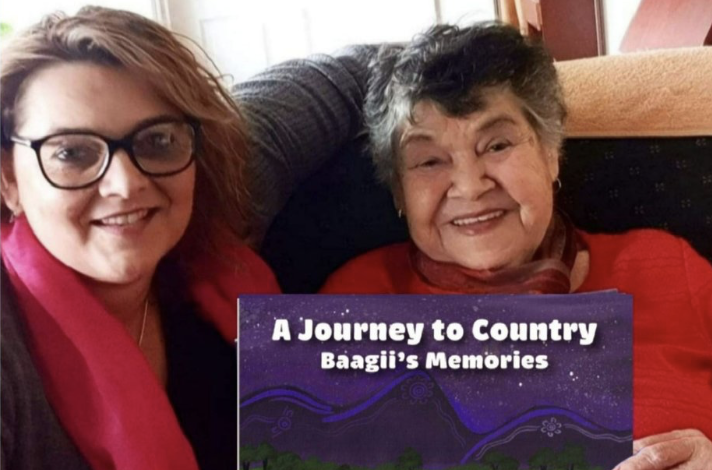
Content warning: This story contains names and images of people who have now passed.
When May Armstrong's mind began travelling back through time, returning her to the frightened seven-year-old who once ran with her family to avoid the Stolen Generations, she found herself in an aged care facility where every meal became a source of terror.
Staff didn't understand that in her mind, her father wasn't there to taste the food first—to protect her from the poison she believed they were giving her.
'In her mind Nan was seven, and she was looking for her dad, and she was afraid to eat or drink because they were poisoning the water,' her granddaughter Mel Armstrong explains. 'She'd be sobbing and crying and shaking because she thought they were trying to poison her.'
This heartbreaking scene isn't just one family's tragedy—it's a window into a crisis that's affecting First Nations communities across Australia with devastating regularity.
A crisis hiding in plain sight
The latest figures from the Australian Institute of Health and Welfare paint a stark picture: among urban and regional dwelling First Nations people aged 60 and over, dementia prevalence sits at 21 per cent—three times higher than the 6.8 per cent rate for the same age group in the general population.
But in remote communities, the situation is even more dire.
In the remote Kimberley region of Western Australia, dementia prevalence among First Nations people aged 45 and over reaches 12.4 per cent. Perhaps most troubling of all, First Nations people develop dementia much younger, with a median age of onset at 72 years compared to 79 years for non-Indigenous Australians.
'There is a deeply held fear of dying away from community and Country. When older Aboriginal and Torres Strait Islander people are forced to receive care away from Country, it can have a profound impact on a person's spiritual, physical and mental wellbeing'
The burden of disease due to dementia among First Nations people is more than twice as high as the rate among non-Indigenous Australians, measured at 13.0 versus 6.1 healthy years of life lost per 1,000 people. For First Nations people aged 75 and over, dementia has become the leading cause of disease burden.
The shocking scale of Indigenous dementia in Australia
First Nations people are 3-5 times more likely to develop dementia
They develop it 7 years earlier on average (age 72 vs 79)
The disease burden is more than double that of non-Indigenous Australians
In remote areas, prevalence rates are among the highest in the world
Dementia is now the leading cause of disease burden for Indigenous people over 75
When the system fails our elders
For Mel Armstrong, watching her grandmother navigate Australia's healthcare system became a seven-week battle that revealed deep-seated institutional failures.
When hospital staff refused to assess May's cognitive ability simply because she was Aboriginal—claiming they weren't 'prepared to take away her freedom' - it highlighted a racism masquerading as sensitivity.
'I didn't ask you to take away her freedom. I asked you to deliver health care,' Mel told them, fighting for basic medical assessment that should have been routine.
The concept of carer burnout took on new meaning for Mel as she juggled caring for her grandmother with work and family commitments. She describes her experience as 'almost complete nervous system collapse' - a state where even the smallest sounds felt overwhelming.
'I was literally feeling sounds all of the time. If the phone rang, it was 10 times louder. Or if the door shut, it was almost like my nerves were sitting on the outside of my body, and I could feel everything,' she recalls.
The tragedy of preventable suffering
New research from the Torres Strait region brings both hope and heartbreak to this crisis. A groundbreaking study has found that over half - 52.1 per cent - of the dementia burden in First Nations populations could be prevented by addressing 11 modifiable risk factors.
Did you know?
Did you know?
The biggest preventable risk factors for dementia in First Nations communities are hypertension (contributing 9.4 per cent of cases), diabetes mellitus (9.0 per cent), obesity (8.0 per cent), and smoking (5.3 per cent). This suggests that targeted health interventions could dramatically reduce dementia rates in these communities.
These results suggest that a substantial proportion of dementia in First Nations peoples could potentially be prevented, making government investment in preventative health essential to reduce the future burden of dementia.
The healing power of Country and culture
Despite the systemic failures, Mel Armstrong discovered something powerful in her grandmother's final years—the profound healing that connection to Country and culture could provide. Taking May back to her birthplace before she entered care proved 'incredibly healing,' making the transition easier for both of them.
'I'd take her outside and sit down by the water, give her the clap sticks,' Mel explains. 'It helped her. She'd be hitting the clap sticks, talking about different things from way back, her old people, things like that. It was healing for Nan.'
Aboriginal Community Controlled Health Services deliver holistic and culturally appropriate health services to communities, and are often a first point of contact for First Nations people with dementia. These services can act as referral points to specialist care and help First Nations people navigate the aged care system.
Fighting for change
The National Aboriginal and Torres Strait Islander Flexible Aged Care Program (NATSIFAC) represents one attempt at culturally appropriate care, but according to Interim First Nations Aged Care Commissioner Andrea Kelly, it needs major reform.
'The NATSIFAC Program is in dire need of reform, as it is currently highly restrictive and almost impossible for new providers to enter,' Kelly explains in her report to government.
There is robust evidence that First Nations people prefer First Nations-specific services, yet access remains limited, particularly in urban and regional areas where most First Nations people now live.
Warning signs and getting help
- Memory problems affecting daily life, especially in people under 80
- Confusion about time, place, or familiar people
- Changes in personality or behaviour
- Difficulty with familiar tasks
- Problems with language or communication
If you notice these signs:
- Contact your local Aboriginal Community Controlled Health Service
- Ask specifically for a proper cognitive assessment
- Don't accept dismissive responses from healthcare providers
- Connect with cultural support services early in the process
A daughter's mission
Following May's death at 92 earlier this year, Mel Armstrong has published a book in her grandmother's honour, hoping to educate people about First Nations experiences of dementia. Her advice to other caregivers reflects both the exhaustion and determination that defines this battle:
'You need to learn to rest, not to quit because it's a long slog that breaks your heart, but it is worth standing up for our people.'
The ARC Centre for Excellence in Population Ageing Research has projected that by 2051, the relative growth in the number of First Nations people aged 50 years and over with dementia will be 4.5 to 5.5 times the 2016 estimated prevalence. Without significant changes to prevention and care systems, thousands more families will face what the Armstrong family endured.
What This Means For You
The crisis facing First Nations elders with dementia isn't just about medical care—it's about recognition, respect, and the fundamental right to age with dignity in connection to Country and culture. As Mel Armstrong learned through her grandmother's journey, 'in a lot of ways she transitioned going backwards, so I got to see the veils sort of drop away in front of me, and I could understand who she was before.'
Every First Nations elder deserves that same opportunity for understanding, healing, and connection in their final chapter—not the fear and isolation that too often defines their experience in our current system.
What stories have you heard about dementia care in your community? Have you encountered barriers when seeking help for an elderly relative? Share your experiences below—your voice matters in pushing for the changes our elders desperately need.
Original Article
https://www.news.com.au/lifestyle/h...a/news-story/87a9ee2a0b5c011dd842ad0c8d0cb09c
Dementia in Australia, Population health impacts of dementia among First Nations people—Australian Institute of Health and Welfare
Cited text: Among urban and regional dwelling First Nations people aged 60 and over, the prevalence of dementia was about 3 times as high as the overall Australia...
Excerpt: The latest figures from the Australian Institute of Health and Welfare paint a stark picture: among urban and regional dwelling First Nations people aged 60 and over, dementia prevalence sits at 21 per cent—three times higher than the 6…
https://www.aihw.gov.au/reports/dem...ulation-health-impacts-dementia-first-nations
Dementia in Australia, Burden of disease due to dementia among First Nations people—Australian Institute of Health and Welfare
Cited text: The rate of burden due to dementia among First Nations people was over twice as high as the rate among non-Indigenous Australians (age-standardised ra...
Excerpt: The latest figures from the Australian Institute of Health and Welfare paint a stark picture: among urban and regional dwelling First Nations people aged 60 and over, dementia prevalence sits at 21 per cent—three times higher than the 6…
https://www.aihw.gov.au/reports/dem...ions-people/bod-dementia-first-nations-people
Dementia in Australia, Population health impacts of dementia among First Nations people—Australian Institute of Health and Welfare
Cited text: For First Nations people aged 45 and over living in the remote Kimberley region of Western Australia, dementia prevalence was 12.4 per cent (Smith et al. 2008...
Excerpt: In the remote Kimberley region of Western Australia, dementia prevalence among First Nations people aged 45 and over reaches 12.4 per cent
https://www.aihw.gov.au/reports/dem...ulation-health-impacts-dementia-first-nations
Dementia in Australia, Population health impacts of dementia among First Nations people—Australian Institute of Health and Welfare
Cited text: First Nations people also had a younger age of onset of dementia, with a median age of 72 years compared with a median age of 79 years among non-Indig...
Excerpt: First Nations people develop dementia much younger, with a median age of onset at 72 years compared to 79 years for non-Indigenous Australians
https://www.aihw.gov.au/reports/dem...ulation-health-impacts-dementia-first-nations
Dementia in Australia, Burden of disease due to dementia among First Nations people—Australian Institute of Health and Welfare
Cited text: Dementia was the leading cause of disease burden for First Nations people aged 75 and over (Table S12.9).
Excerpt: For First Nations people aged 75 and over, dementia has become the leading cause of disease burden
https://www.aihw.gov.au/reports/dem...ions-people/bod-dementia-first-nations-people
Potentially preventable dementia in a First Nations population in the Torres Strait and Northern Peninsula Area of North Queensland, Australia: A cross sectional analysis using population attributable fractions—The Lancet Regional Health—Western Pacific
Cited text: Half (52·1 per cent) of the dementia burden in this population may be attributed to 11 potentially modifiable risk factors.
Excerpt: A groundbreaking study has found that over half—52.1 per cent—of the dementia burden in First Nations populations could be prevented by addressing 11 modifiable risk factors
https://www.thelancet.com/journals/lanwpc/article/PIIS2666-6065(22)00147-X/fulltext
Potentially preventable dementia in a First Nations population in the Torres Strait and Northern Peninsula Area of North Queensland, Australia: A cross sectional analysis using population attributable fractions—The Lancet Regional Health—Western Pacific
Cited text: Hypertension (9·4 per cent), diabetes mellitus (9·0 per cent), obesity (8·0 per cent), and smoking (5·3 per cent) were the highest contributing risk factors.
Excerpt: The biggest preventable risk factors for dementia in First Nations communities are hypertension (contributing 9.4 per cent of cases), diabetes mellitus (9.0 per cent), obesity (8.0 per cent), and smoking (5.3 per cent)
https://www.thelancet.com/journals/lanwpc/article/PIIS2666-6065(22)00147-X/fulltext
Potentially preventable dementia in a First Nations population in the Torres Strait and Northern Peninsula Area of North Queensland, Australia: A cross sectional analysis using population attributable fractions—The Lancet Regional Health—Western Pacific
Cited text: These results suggest that a substantial proportion of dementia in FNQ First Nations peoples could potentially be prevented. Government investment in ...
Excerpt: These results suggest that a substantial proportion of dementia in First Nations peoples could potentially be prevented, making government investment in preventative health essential to reduce the future burden of dementia
https://www.thelancet.com/journals/lanwpc/article/PIIS2666-6065(22)00147-X/fulltext
Dementia in Australia, First Nations-specific health and aged care programs and caring roles among First Nations people—Australian Institute of Health and Welfare
Cited text: Aboriginal Community Controlled Health Services (ACCHS) deliver holistic and culturally appropriate health services to communities, and are often a fi...
Excerpt: Aboriginal Community Controlled Health Services deliver holistic and culturally appropriate health services to communities, and are often a first point of contact for First Nations people with dementia.
https://www.aihw.gov.au/reports/dem...a/first-nations-health-aged-care-caring-roles
Dementia in Australia, First Nations-specific health and aged care programs and caring roles among First Nations people—Australian Institute of Health and Welfare
Cited text: There is robust evidence that First Nations people prefer First Nations-specific services.
Excerpt: There is robust evidence that First Nations people prefer First Nations-specific services
https://www.aihw.gov.au/reports/dem...a/first-nations-health-aged-care-caring-roles
Dementia in Australia, Population health impacts of dementia among First Nations people—Australian Institute of Health and Welfare
Cited text: The ARC Centre for Excellence in Population Ageing Research projected that by 2051, the relative growth in the number of First Nations people aged 50 ...
Excerpt: The ARC Centre for Excellence in Population Ageing Research has projected that by 2051, the relative growth in the number of First Nations people aged 50 years and over with dementia will be 4.5 to 5.5 times the 2016 estimated prevalence
https://www.aihw.gov.au/reports/dem...ulation-health-impacts-dementia-first-nations







